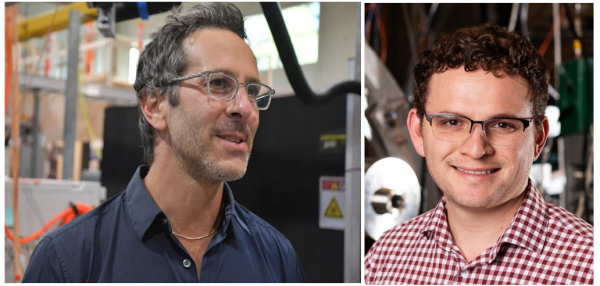
Ben Levitt (left) and Derek Sutherland (right)
Ben Levitt & Derek Sutherland
ZAP Energy
Tuesday, May 7, 2024
12:00pm
Zoom Only
Abstract : The sheared-flow-stabilized (SFS) Z-pinch fusion concept, developed at the University of Washington with LLNL collaborators, is now on a path to commercialization at Zap Energy. Recent experiments corroborate predicted thermonuclear fusion reaction rates, as the plasma current is scaled toward higher gain performance. Experimental campaigns utilizing two SFS Z-pinch platforms, FuZE and FuZE-Q, are underway to increase the triple product, pinch stability duration, and DD fusion neutron production to reach scientific breakeven.
In this presentation, we will introduce Zap Energy, the SFS Z-pinch concept, and report recent results from both experimental platforms, demonstrating operation with thermonuclear plasmas. Electron temperatures in excess of 2 keV are measured with Thomson scattering, placing a lower bound on ion temperature, which is also independently inferred from impurity radiation spectra to be greater than 2.5 keV. Simultaneous Thomson electron density measurements result in pinch pressure profiles in agreement with predictions by analytical and computational models. These devices produce DD neutron yields that scale strongly with plasma current (Yn~I11) up to absolute yields ~1010 neutrons/pulse, consistent with adiabatic scaling of a SFS Z pinch and with 2D MHD modeling results. These recent advances in performance constitute a factor of 10^5 improvement in fusion yield since 2021.
Additionally, we will present our methodology for calculating scientific gain in a SFS Z-pinch and detail the impact of impurities and potential redeposited alpha heating on power balance. Zap Energy also has parallel programs developing power handling systems suitable for future power plants. An overview of technologies under development will be presented, including high-average-power repetitive pulsed power, high-duty-cycle cathodes, and liquid metal wall systems.
Bio: Dr. Levitt is Vice President of Research and Development at Zap Energy, a private fusion company based out of Seattle, WA, developing commercial fusion energy based on a stabilized Z-pinch concept. Ben gained a PhD in experimental plasma physics from Columbia University studying dipole-confined plasmas, and, following a postdoctoral fellowship at CERN and Harvard, has spent much of his career studying devices at the confluence of plasma and accelerator physics, spanning energy ranges from near absolute zero to tens of GeV and confinement devices for single electrons up to fusion grade plasmas. Reproducing the Earth’s plasmasphere or trapping cold antimatter plasmas were focuses of his academic career. He left academia with a desire to work on applied problems in industry, spending over a decade at Schlumberger-Doll-Research in Cambridge, MA, developing, industrializing, and commercializing novel accelerators for industrial applications. Ben joined Zap Energy in January 2021 as VP of Research and Development, the Zap team that develops and operates the fusion core for their ultimate fusion power plant. He leads the team of over 50 scientists and engineers as they tackle the multi-disciplined challenges necessary to scale Zap’s ‘Sheared-Flow-Stabilized Z-Pinch’ configuration to commercial fusion energy.
Derek Sutherland is the Head of FuZE-Q Physics at Zap Energy, a company focused on the development of the sheared-flow-stabilized (SFS) Z-pinch for commercial fusion energy. He completed his Ph.D. in 2019 in the Department of Aeronautics and Astronautics from the University of Washington in Seattle, where he focused on the development of inductively sustained spheromak configurations. He founded CTFusion, Inc. and served as the PI of ARPA-E funded projects focused on advancing the inductively sustained spheromak before joining Zap Energy in 2023.
Dr. Sutherland has experience in experimental, computational, and theoretical plasma physics, and fusion energy system design and engineering. Prior to his Ph.D., he received his B.S. from MIT in Nuclear Science and Engineering and in Physics where he was a co-author on the the ARC reactor and had the opportunity to work on a multitude of fusion concepts at MIT, General Atomics, General Fusion, and Los Alamos National Laboratories.
Dr. Sutherland’s primary research interests include experimental, computational, and theoretical studies of magnetic confinement and magneto-inertial fusion concepts for both terrestrial power generation and space propulsion. Specific areas of interest include plasma-neutral interactions, edge/boundary physics, core-edge integration, Extended-magnetohydrodynamic (MHD) plasma simulations, MHD stability analysis, nuclear materials and blanket neutronics, fusion energy system design and commercialization, and global energy markets. Lastly, Dr. Sutherland currently is serving as a member of FESAC for a three-year term that began in January 2024.
Zoom Link: https://mit.zoom.us/j/4981061812